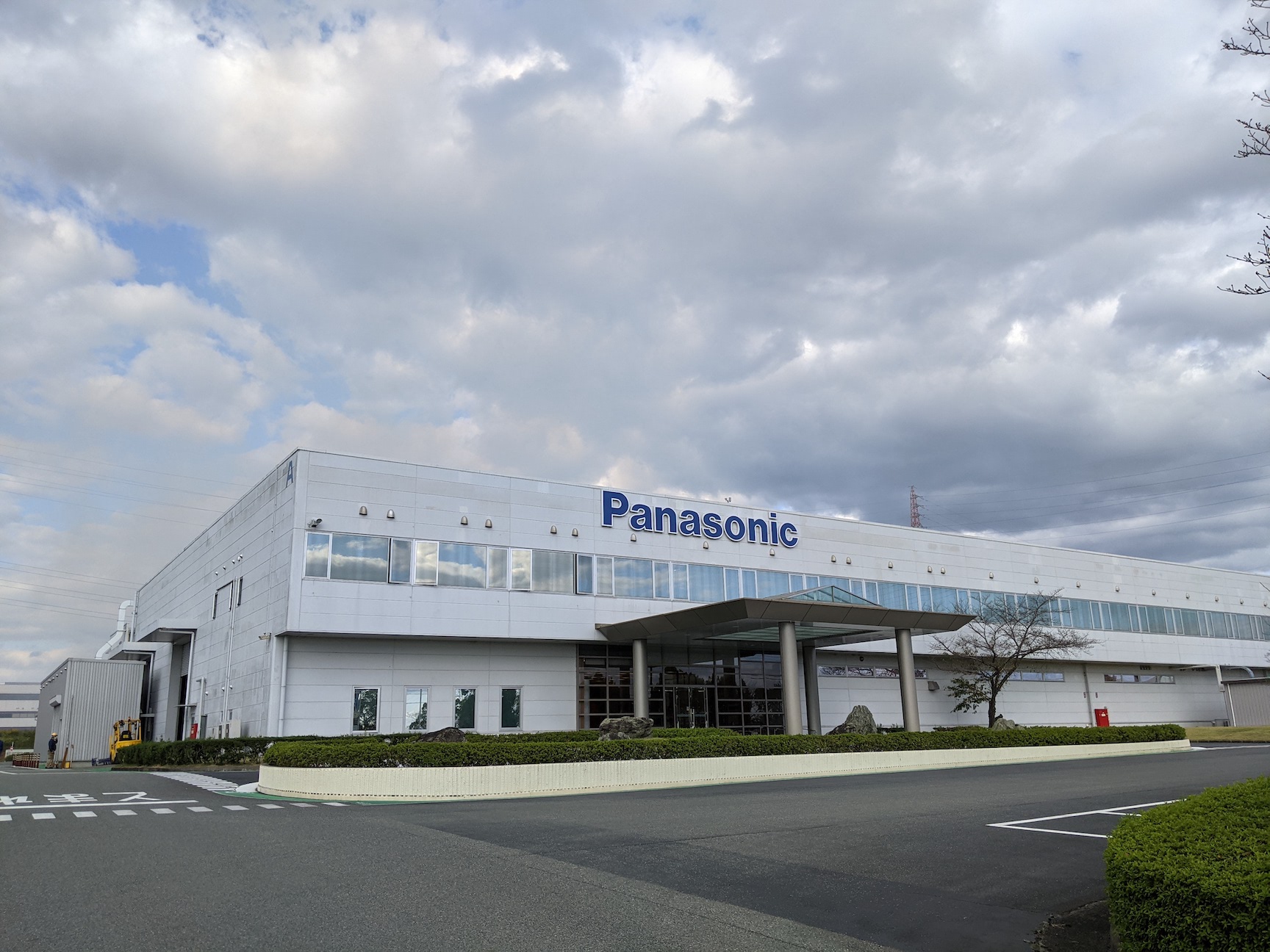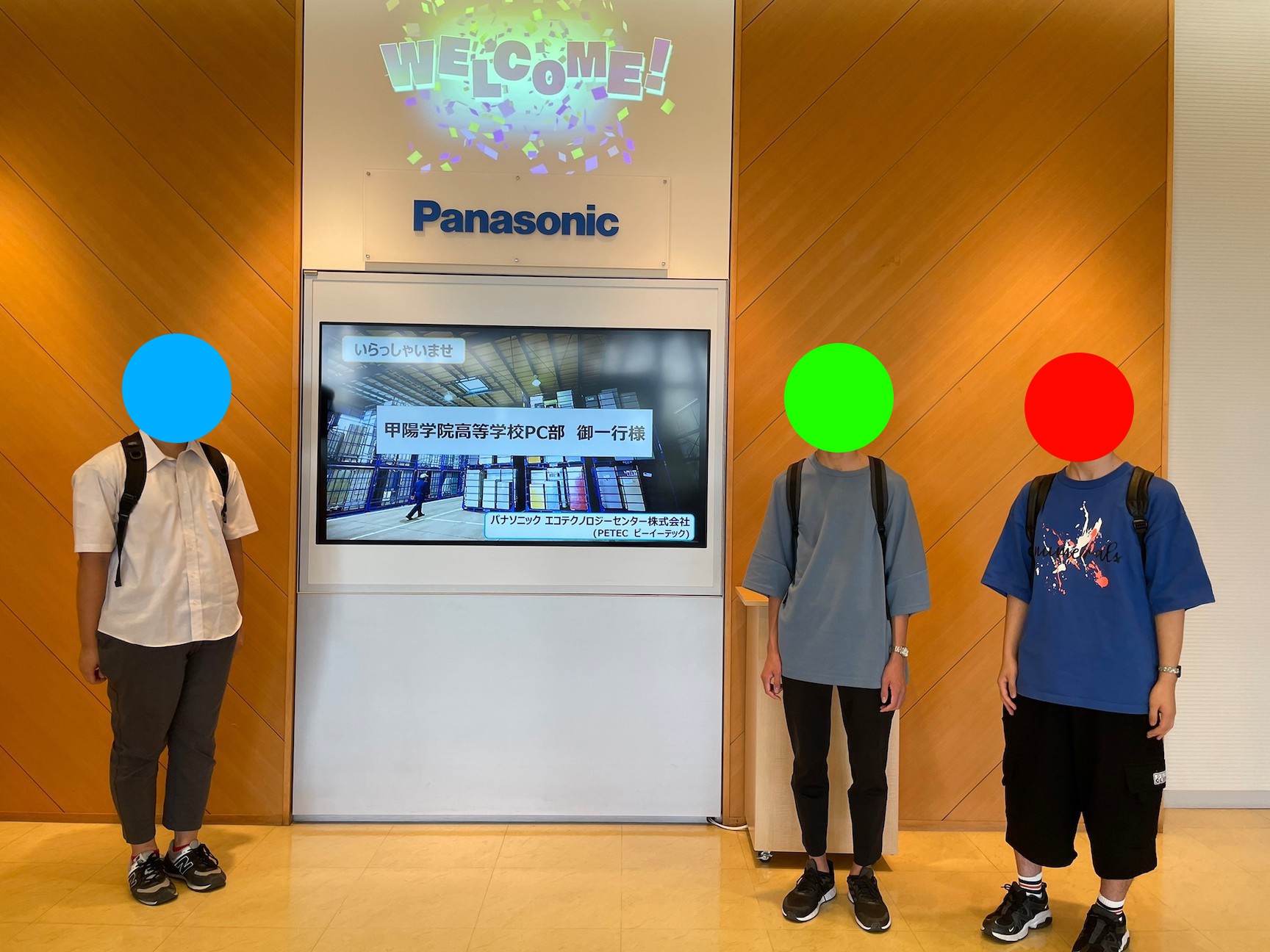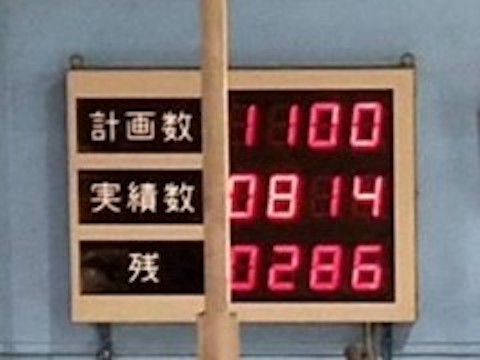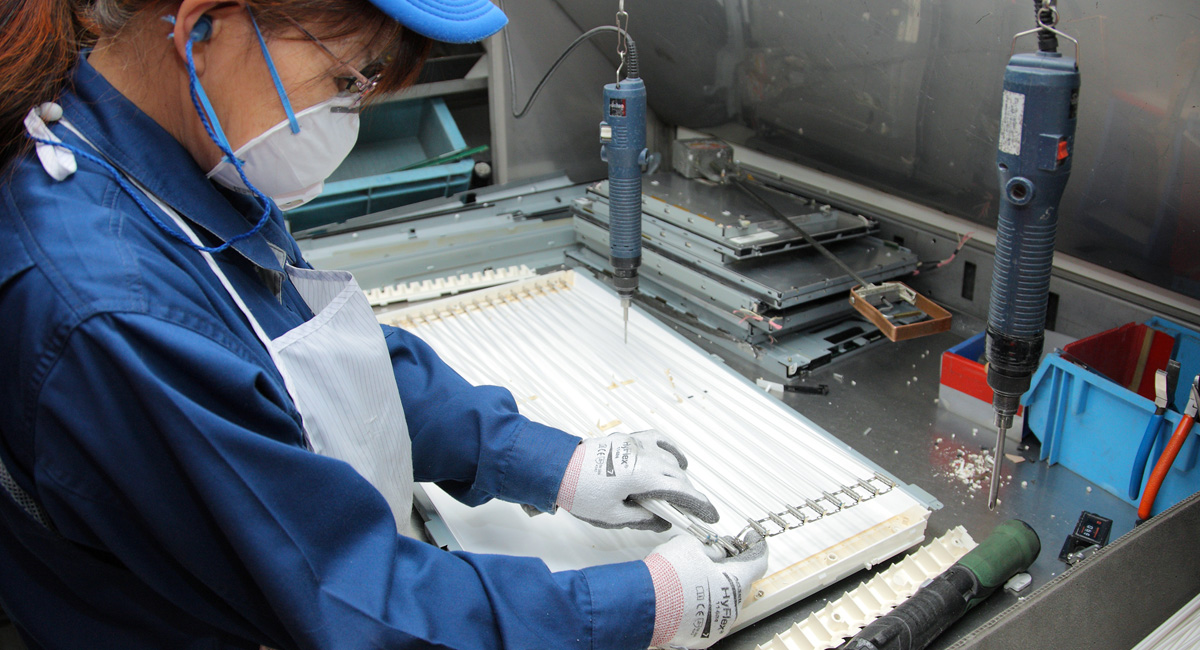工場見学
2021年10月14日に兵庫県加東市にあるパナソニックエコテクノロジーセンター(PETEC)に見学に行きました。
PETECってどんなところ?
ここまで読んでくださった皆さんは、小型家電のリサイクルがとても重要だということがお分かりになったかと思います。 同様に、テレビや冷蔵庫などの大型家電のリサイクルもとても重要です。 その大型家電のリサイクルを担っている会社の一つがPETECです。 PETECは、「トレジャーハンティング(宝探し)」を合言葉にリサイクルを行い、周囲の環境にも配慮して循環型社会の実現を目指しています。
PETECは、家電リサイクル法 家電リサイクル法 エアコン、テレビ(ブラウン管、液晶・プラズマ)、冷蔵庫・冷凍庫、洗濯機・衣類乾燥機の家電4品目を対象とした法律。後払い制度がとられている。これらの家電の回収により、リサイクルの促進だけでなく、廃棄物の減量も目指している。 で指定されている4品目(テレビ、エアコン、冷蔵庫・冷凍庫、洗濯機・衣類乾燥機)を扱っています。 その家電を回収する地域は近畿2府4県にも及びます。
大型家電の処理数は年間で約90万台で、稼働日ごとに明確な目標処理台数を決めて作業しています。
基本的にその台数は安定しているのですが、時には大幅に増えることもあるそうです。
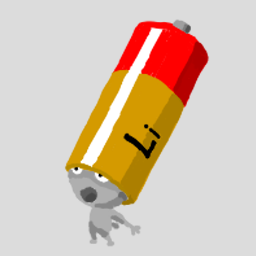
大型家電リサイクルには、各品目についての法定リサイクル率 法定リサイクル率 国によって定められているリサイクル率。工場でのリサイクル率がこれを下回ってしまうと稼働できなくなってしまう。エアコンでは80%、テレビでは55%というように品目ごとに決まっている。 というものが家電リサイクル法で定められています。 工場でのリサイクル率がこれを超えなければ、工場は稼働できません。 PETECでは、いずれの品目においても法定リサイクル率をクリアしています。(表5.1)
| テレビ | エアコン | 冷蔵庫・冷凍庫 | 洗濯機・衣類乾燥機 | |
|---|---|---|---|---|
| 法定リサイクル率 | 74% | 80% | 70% | 82% |
| PETECでのリサイクル率 (2020年度) |
89% | 95% | 82% | 95% |
どのようにリサイクルされるの?
PETECで行われているリサイクルの工程を製品別に紹介しようと思います。
テレビ
テレビはブラウン管テレビ、プラズマテレビ、液晶テレビの3つに分類されます。 ただし、現在は家庭からのブラウン管テレビの排出量が少ないので、PETECでは扱われていません。 液晶テレビには蛍光管タイプのバックライト バックライト 背面から液晶を照明するもの。 が使用されているものがあります。 その中には有害物質である水銀ガスが含まれているため、バックライトユニットの蛍光管を回収する必要があります。 回収した蛍光管は専門の業者で処分されます。
次は、分別と回収という作業に入ります。 そこでは主に金属素材が含まれる基板などが取り出されます。
また作業効率を上げるために、コンベア式の解体ラインが工場内に張り巡らされています(よく車の製造工場に大規模な生産ラインが続いている写真を見ますよね)。 そこで取り出された金属は精錬所に送られ、新たな資源に生まれ変わります。
エアコン
まず、エアコンは室内機と室外機に分けられます。 室内機は従来、外装、送風ファンの取り外し、内部の解体までの全てを人の手で行っていましたが、PETECでは装置を使ってモーターと電源が集まっているところを切断することで自然とネジが外れるので解体の手間を省いて、作業負担を減らしています。 一方、室外機には冷媒フロンが存在します。 冷媒フロンはオゾン層を破壊する原因ともいわれているので、先に取り除く必要があります。 この取り除きはチューブを使って安全に行われ、その後専用の処理工場で無害化されることになっています。 室外機にはホコリや虫の死骸などがついていることがあるので、除去した後、解体します。
室内機・室外機の解体された部分は銅線、筐体 筐体 何らかの機能を有する機械や電気機器などを中に収めた箱のこと。 、電気部品類、熱交換器、コンプレッサーなどに分別されます。 特に、室外機に含まれるコンプレッサーは鉄と銅を多く含む貴重な資源であるそうです。 銅線からは、破砕された後に銅が回収され、精錬所に送られます。 電気部品類、熱交換器、コンプレッサーも別の工場へ行き、高品位・高純度に資源が回収されて新しいものへと生まれ変わります。
筐体などの部分からは特殊な分離方法を用いて、鉄、銅、アルミ、プラスチックに分けられます。 この分離方法のデモは、見学の時に見ることができました!
~筐体が選別回収される工程~
-
- <磁力選別機>
- 役割:磁石につくものとそうでないものに分ける
-
手順:
- 混合物が投入され、回転式ドラムに沿って移動します。
- 鉄以外は磁石につかないためある程度のところで落下します。
- 鉄は磁石がなくなるところで落下します。
-
- <非鉄金属選別機>
- 役割:磁石につかない金属(非鉄金属)と金属以外を分ける
-
手順:
- 混合物が投入され、コンベヤベルトに沿って進みます。
- 磁石が高速回転することで、移動磁界が生まれます。
- 磁石を通過する非鉄金属に渦電流が発生します。
- 非鉄金属は磁力と渦電流との相互作用によって飛び出します。
- 渦電流を発生させないプラスチックは自然に落下します。
-
- <比重選別機>
- 役割:重いものと軽いものを分ける
-
手順:
- 混合物(銅とアルミ)が投入されます。
- アルミは軽いため、下からの風に吹き上げられ、下の方向に移動していきます。
- 重い銅は風に吹き上げられずに、台の振動によって上の方向に移動していきます。
冷蔵庫・冷凍庫
まず、冷蔵庫内に食べ物が残っていないかどうかを確認し、残っている場合はそれを取り出します。 次に、冷媒や断熱材にフロンが使われているかいないかなどの観点から冷蔵庫を種類分けし、ラベルでそれを示します。 この作業が、後の解体の効率を随分上げているそうです。
野菜箱や食品棚などのプラスチック(PP、PS)は破砕され、樹脂加工会社で洗浄、異物除去、出荷検査を行った後に新たな製品の一部として使われます。 また、冷蔵庫から取り出されたコンプレッサーからは有害物質であるフロンが抜き取られ、その後に他の会社で無害化されます。 残ったコンプレッサーは金属加工会社に送られた後、再資源化されます。
続いて、冷蔵庫本体については断熱材にフロンガスが使われている物と使われていない物とで別々に破砕されることになっています。 フロンタイプのものは破砕の際にフロンが抜き取られ、冷媒フロン同様、他の会社で無害化されます。 フロンガスが取り出された後の本体は、専用の破砕機で金属やプラスチックの混ざった破片群になり、そこから個々の資源が取り出されていきます。
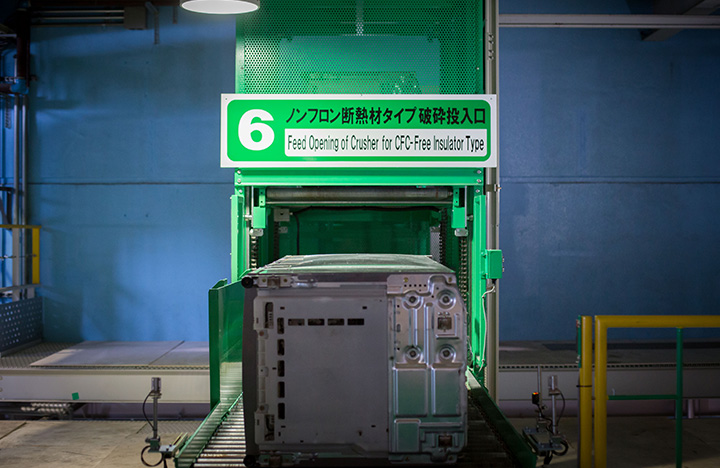
Data Source : ホームページより引用
~粉々の冷蔵庫が選別回収される工程~
-
- <風力選別機>
- 役割:重いものと軽いものを分ける
-
手順:
- 混合物が投入されます。
- ウレタンは軽いため、下からの風で吹き上げられ、そのまま吸引口へと吸い込まれます。
- ウレタン以外は風に吹き上げられることなく下へと落ちます。
-
- <磁力選別機>
- エアコンの磁力選別機と同じです。
-
- <非鉄金属選別機>
- エアコンの非鉄金属選別機と同じです。
-
- <高精度樹脂選別システム>
- 役割:プラスチックをABS、PP、PSに分ける
-
手順:
- ABS、PP、PSの混ざったプラスチックがコンベヤから飛び出します。
- エアノズルが即座に種類を判別し、適当なタイミングで空気を噴射します。

このように冷蔵庫は多くの工程を踏まなければいけないことから、4品目の中で最もリサイクルが難しいと言われているそうです。
洗濯機・衣類乾燥機
乾燥機付き洗濯機もエアコンと同じように、コンプレッサーや熱交換器が取り出され、フロンも回収されます。 また、洗濯機からはハーネス ハーネス 洗濯機、冷蔵庫等の家電や自動車等の内部配線に使用されるもので、電源供給や信号通信を目的に複数の電線を束状にし配線し易い長さ形状にしたもの。 やモーター、操作パネルや電源コードを手作業で取り出します。 洗濯機が他の製品と異なるところは、塩水を抜き取らなければいけないということです。塩水は洗濯をするときに回転する洗濯槽を安定させるためにバランサー代わりに2Lほど入っているのですが、それを取り除くことで大切なリサイクル資源である鉄がさびてしまうのを防ぐことができるのです。 また、取り除かれた塩水は他の工場へと送られ、再利用されます。
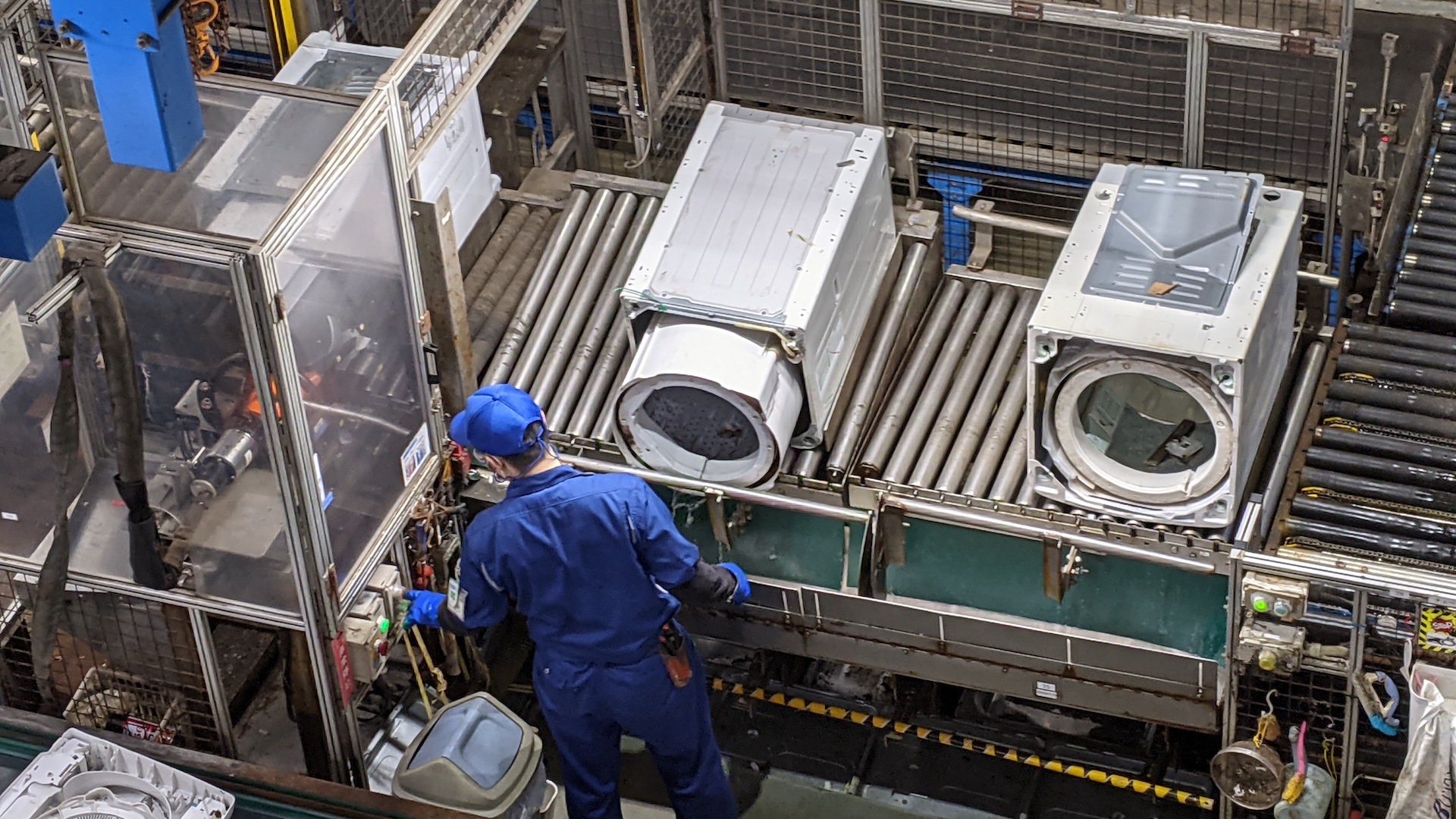
その後、洗濯機は破砕機へと向かいます。 破砕機で細かくされた後は、磁力選別、非鉄選別などを経て、鉄やアルミ、銅、プラスチックに分離され、回収されます。 (ここでの磁力選別や非鉄選別は、エアコンや冷蔵庫で紹介したものと同じです。)
リサイクル料金について
しかしこれらの製品をリサイクルしてもらうにはどうしてもリサイクル料金を払わなければなりません。 これは家電リサイクル法で私たち消費者側に課せられた役割であり、それと同時にリサイクルを促進させる潤滑油でもあるのです。 「リサイクルするのにお金を払わなければならないの?」 そう思われている方もいるかもしれません。実は、技術の発達や商品のリサイクルのしやすさの向上などから、リサイクル料金は減ってきているのです。(表5.2)
| 4品目 | 区分 | 2001年(税抜) | 2021年(税抜) | |
|---|---|---|---|---|
| テレビ | ブラウン管式 | 16型以上 | 2700円 | 2200円 |
| 15型以下 | 1200円 | |||
| 薄型 | 16V型以上 | (2009年〜) | 2700円 | |
| 15V型以下 | 1700円 | |||
| 冷蔵庫・冷凍庫 | 171L以上 | 4600円 | 4300円 | |
| 170L以下 | 3400円 | |||
| 洗濯機・衣類乾燥機 | 2400円 | 2300円 | ||
| エアコン | 3500円 | 900円 | ||
それでもリサイクル料金を決して安いという風に思えない方もいると思います。 しかし、誰もが「リサイクル料金は高いから」と使用済み家電をリサイクルしない、あるいは違法事業者に出すならば地球の資源はすぐに底をついてしまいますよね。 「地球の資源を守る。」そのためには私たち一人一人が責任ある行動をとらなければなりません。 リサイクル料金を支払ってリサイクルをすることはリサイクル料金と比べ物にならないくらい価値のあることなのではないでしょうか。
PETECの見学を通じて感じたこと
工場見学を通じて一番印象に残っていることが、オフィスにしても解体レーンにしてもとてもきれいに整えられていて、私たち見学者にとても配慮されていると感じたことです。 特に解体レーンは製品ごとにはっきりと色分けされており、解体の説明を受ける際にもとてもわかりやすく感じました。 この色分けは見学者に対する配慮のためだけでなく、従業者さんの安全のためでもあるそうです。 工場見学を行うことが会社の内部を公開し、信頼に繋がっているというお話を聞いて、なるほどなと思いました。
また、工場の倉庫にたくさんのテレビやエアコンが並んでいるのを見て、これらの製品が適切にリサイクルされずに不法に処理される場面を想像するとゾッとしました。 PETECの役割がいかに大切か分かった気がします。
PETECの周りの風景
田んぼを一面に見渡すことができ、非常に静かでのどかな印象を受けました。 PETECの位置する加東市は酒米・山田錦が有名だとか。 皆さんも自然豊かな加東市にぜひぜひ来てみてください!
Visit to Plant
On October 14, 2021, we visited Panasonic Eco Technology Center (PETEC), which is in Kato City, Hyogo Prefecture.
Role of PETEC
We suspect that you realize how important recycling small home appliances is if you have read our website up to here. Actually,recycling large appliances such as televisions and refrigerators is also an essential problem. PETEC is one of the companies responsible for it and aims to achieve a sound recycling-oriented society by recycling under the slogan of "treasure hunting," considering the surrounding environment.
They recycle four items (televisions, air conditioners, refrigerators / freezers, washing machines / clothes dryers), which are specified by the Act on Recycling of Specified Kinds of Home Appliances the Act on Recycling of Specified Kinds of Home Appliances The law covering four home appliances: air conditioners, televisions (CRT, LCD, and plasma), refrigerators/freezers, and washing machines/clothes dryers. A deferred payment system has been adopted. By collecting these home appliances, it aims not only to promote recycling but also to reduce the amount of waste. . The area which large home appliances are collected by PETEC from extends to Kinki area.
They process about 900,000 units per year, and work with a target number of units to be processed, which is usually stable, but sometimes increases significantly, each operating day.

In recycling of large home appliances, the statutory recycling rate the statutory recycling rate The recycling rate set by the government. If that at a plant is lower than it, it will not be able to operate anymore. It is specified for each item, such as 80% for air conditioners and 55% for televisions. for each item is set by the Home Appliance Recycling Law. If it at a plant is below this level, the plant cannot operate. PETEC has met the legal recycling rate for all items. (table 5.1)
| television | air conditioner | refrigerrator, freezer | washing machine, laundry drier |
|
|---|---|---|---|---|
| the statutory recycling rate | 74% | 80% | 70% | 82% |
| the recycling rate at PETEC (2020年度) |
89% | 95% | 82% | 95% |
Recycling Process
We would like to introduce a recycling process carried out at PETEC by product.
Television
Televisions are classified into three types: CRT televisions, plasma televisions, and LCD televisions. However, because the amount of CRT Televisions emitted from households is currently small, they are not processed at PETEC. Some LCD Televisions use fluorescent tube type backlights backlights Lights that illuminate the LCD from the backside. . Since they contain mercury gas, which is a hazardous substance, the fluorescent tubes in the backlight unit need to be taken out. After being taken out, the collected fluorescent tubes are disposed of by a specialized company.
Data Source : HPより引用
Next, substrates, which contain mainly metal materials, are removed.
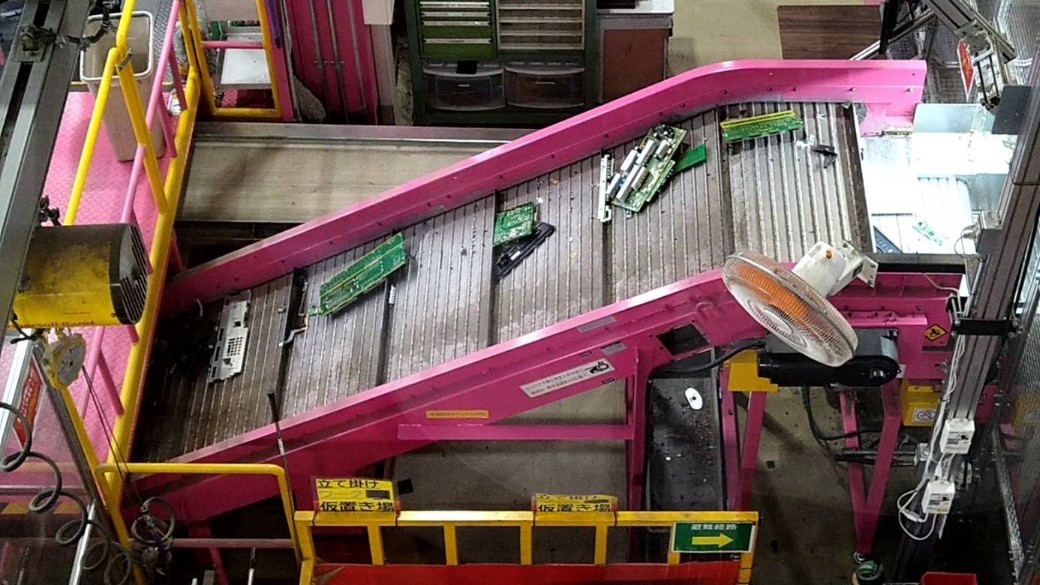
In order to make the process more efficient, conveyorized dismantling lines are set throughout PETEC (you often see pictures of large-scale production lines in car manufacturing plants, don’t you?). The removed metals are sent to smelters to be turned into new resources.
Air conditioners
Air conditioners are classified into indoor units and outdoor units. The process of dismantling indoor units, including removal of exteriors and blower fans, and dismantling of the interior, used to be done by hand, but PETEC uses a device to cut where motors and power come together, which results in taking out screws in them, thus reducing work. On the other hand, there is refrigerant CFC in outdoor units. It is said to destroy the ozone layer, so it must be removed first. This removal is done safely using a tube and then sent to a special treatment plant and detoxified in it. Outdoor units sometimes have dust and dead insects in them, so in that case, they are removed before outdoor units are dismantled.
The dismantled parts of indoor and outdoor units are divided into copper wire, chassis chassis A box which contains a machine or electrical equipment with some function inside. , electrical parts, heat exchangers, compressors, etc. In particular, the compressor contained in outdoor units is a valuable resource which contains a lot of iron and copper. After the copper wire is crushed, the copper is recovered and sent to a smelter. Electrical parts, heat exchangers, and compressors are carried to a plant where the resources are recovered in high grade and transformed into new ones.
The chassis is separated into iron, copper, aluminum, and plastic, using a special method. We could see demonstrations of it in PETEC!!
~The process which the chassis is sorted and collected through.~
-
- <Magnetic sorting machine>
- Role: Sort into what is magnetic and what is not.
-
Procedure:
- Mixtures are fed in and move along the rotating drum.
- Anything other than iron falls at some point because it is not magnetic.
- Iron falls where the magnet disappears.
-
- <Non-ferrous metal sorting machine>
- Role: Separate non-magnetic metals (non-ferrous metals) from non-metals.
-
Procedure:
- Mixtures are put in and proceed along the conveyor belt.
- A moving magnetic flux field is created by the high-speed rotation of the magnet.
- An eddy current is generated in the nonferrous metal passing through the magnet.
- The nonferrous metal is flung out by the interaction of the magnetic force and the eddy current.
- Plastic, which does not generate eddy currents, falls naturally.
-
- <Specific gravity sorting machine>
- Role: Separate heavy items from light ones.
-
Procedure:
- Mixtures (copper and aluminum) are thrown in.
- Because aluminum is light, it is blown up by the wind from below and moves downward.
- Copper is not blown up by the wind but moves upward by the vibration of the platform, because it is heavy.
Refrigerators・Freezers
First, check to see if there is any food left in refrigerators, and if so, remove it. Next, the refrigerators are categorized according to whether or not CFCs are contained in refrigerants or insulation, and labeled to indicate this. This process makes dismantlement later more efficient.
Plastic (PP, PS) such as vegetable boxes and food shelves are crushed and used as parts of new products after cleaning, removing foreign substances, and shipping inspection at resin processing companies. In addition, CFCs, which are harmful substances, are extracted from the compressor removed from refrigerators, and then detoxified by another company. The remaining compressor is sent to a metal processing company for recycling.
Refrigerators themselves are classified whether or not they have CFCs in them before crushed. If CFCs are contained in them, CFCs are removed during the crushing process and are made harmless by another company like refrigerant CFCs. After the CFC gas is extracted, the main body is crushed by a special crusher into a group of mixed metal and plastic fragments, from which the resource is extracted separately.

Data Source : HPより引用
~The process which shattered refrigerators are sorted and collected through~
-
- <Wind power sorting machine>
- Role: Separate heavy items from light ones.
-
Procedure:
- Mixtures are put in.
- Urethane, which is light, is blown up by the wind from below and pulled directly into the suction port.
- All but the urethane fall down instead of being blown up by the wind.
-
- <Magnetic sorting machine>
- It is the same as that for air conditioners.
-
- <Non-ferrous metal sorting machine>
- It is the same as that for air conditioners.
-
- <High-precision plastic sorting system>
- Role: Classify plastics into ABS, PP, and PS.
-
Procedure:
- Plastic which is mixed with ABS, PP, and PS pops out of the conveyor.
- The air nozzles immediately identifies it and sprays air at appropriate times.

As you can see, refrigerators are said to be the most difficult of the four items to recycle due to the many processes that must be followed.
Washing Machines and Clothes Dryers
Like air conditioners, washing machines with dryers have their compressors and heat exchangers removed, and CFCs are recovered. Also, the harnesses harnesses Used in the internal wiring of home appliances such as washing machines and refrigerators, as well as of automobiles, etc. Multiple wires are bundled for power supply and signal communication, and made into a lengthy form that is easy to wire. , motors, control panels, and power cords are taken out of the washing machine by hand. Washing machines are different from other products in that the salt water in them must be drained. About 2 liters of salt water is put in the washing tank as a balancer to stabilize the rotating tank during washing, and removing it prevents the iron, an important recyclable resource, from rusting. The removed salt water is sent to other plants for recycling.

Then, washing machines are sent to the crushers. After being shredded by crushers, they are separated into iron, aluminum, copper, and plastic through magnetic sorting and non-ferrous sorting, and then recovered. (Magnetic sorting and non-ferrous sorting here are the same as those introduced in air conditioners and refrigerators.)
About Recycle Fees
However, in order to have these products recycled, you have to pay a recycling fee. This is a role imposed on us, the consumers, by the Home Appliance Recycling Law, and also it is a lubricant that promotes recycling. Some people may think that they have no idea why they have to pay money in order to recycle products. Actually, recycling fees have been decreasing year by year because of the development of technology and the ease of recycling them. (table 5.2)
| 4品目 | 区分 | 2001年(税抜) | 2021年(税抜) | |
|---|---|---|---|---|
| television | CRT | 16型以上 | 2700円 | 2200円 |
| 15型以下 | 1200円 | |||
| flat-screen | 16V型以上 | (2009年〜) | 2700円 | |
| 15V型以下 | 1700円 | |||
| refrigerrator, freezer | 171L以上 | 4600円 | 4300円 | |
| 170L以下 | 3400円 | |||
| washing machine, laundry drier | 2400円 | 2300円 | ||
| air conditioner | 3500円 | 900円 | ||
There are still some people who do not think that they are cheap. However, if everyone did not recycle their used home appliances claiming that recycling fees are too expensive or if they recycled them illegally, the earth's resources would soon run out, right? "Conserve the Earth's resources." In order to do so, each of us must be responsible for what you do. Paying recycling fees to recycle is much more valuable than recycling fees, isn't it?
Thoughts over Visit
What impressed us the most during the factory visit was the cleanliness of the office and dismantling lanes, which we felt was very considerate to us visitors. In particular, the dismantling lanes were clearly color coded for each product, which made it very easy for us to understand when we were being explained about the dismantling process. We were told that this color coding is not only for the consideration of visitors, but also for the safety of the employees. When we heard that the factory tour is a way to open the inside of PETEC to the public, and that it leads to trust, we thought it is a reasonable way.
We were also horrified to see so many televisions and air conditioners lined up in the warehouse of the factory and imagine the scene where these products were illegally disposed of without being properly recycled. We think we understand how important role PETEC is playing.
Scenery around PETEC
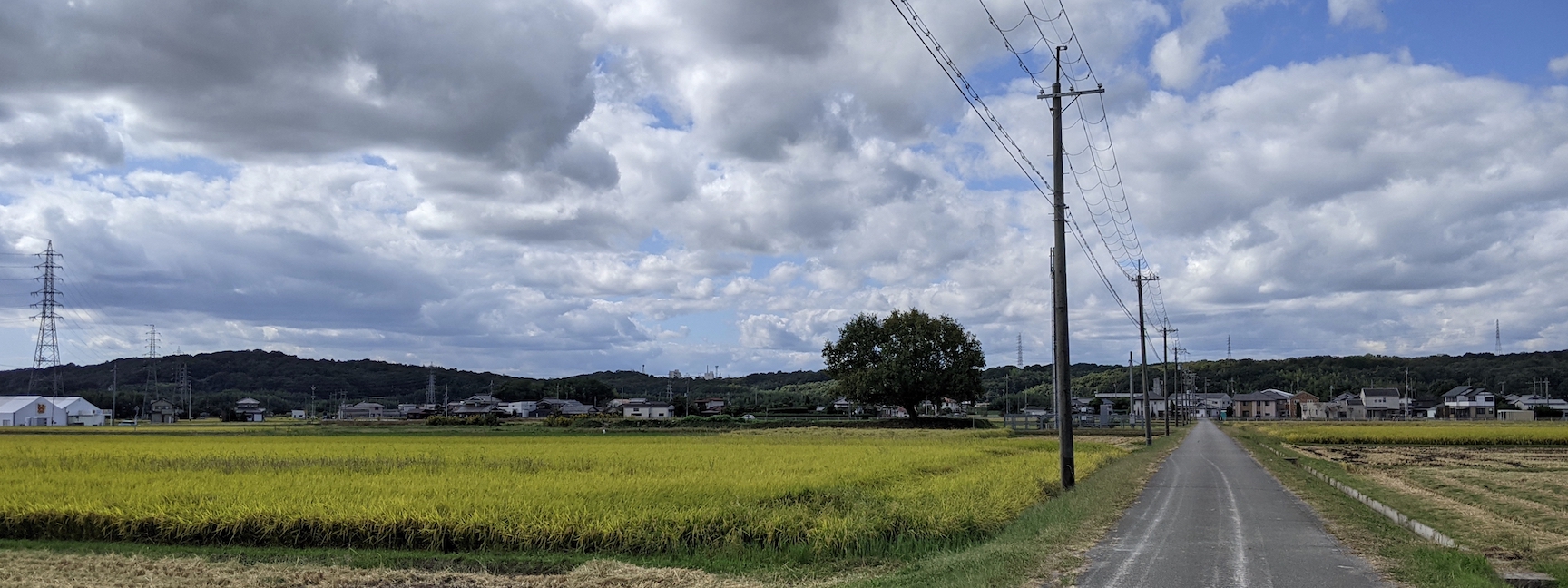
The view of the rice fields was very tranquil and peaceful. We heard that Kato City, where PETEC is located, is famous for its sake rice, Yamada Nishiki. We would like everyone to visit Kato City, a city rich in nature!
